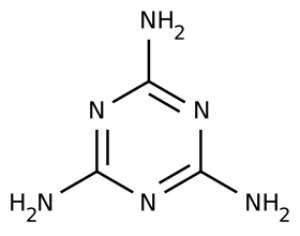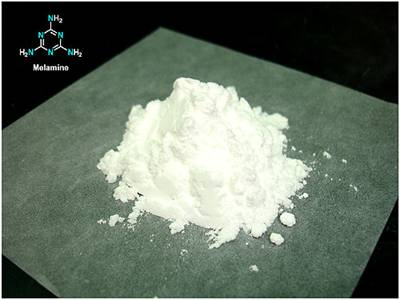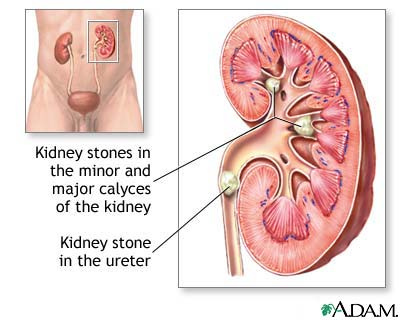
Comments and Information about
“MELAMINE” Toxicity
by: Arthur Evangelista, PhD, former FDA investigator
Public Health & Medical Fraud
Research Cooperative
Nov. - Dec. 2008
With the advent of yet another toxic food scenario, and in light of previous serious problems with our deteriorating food safety, corporate-government malfeasance, the outlook for our food supply is looking dismal.
The enmeshment of government and big business is sickening. The regulatory agencies will provide the corporations with every kind and type of support, as long as people do not complain about regulatory ineffectiveness or government supporting big business with too loud a voice. That is, if the people even become aware of these issues, especially since the major network news are so adulterated with political spin, as well.
First of all, for myself, I often wonder why government allocates a certain level of toxins in foods, water, environment, their containers, etc, rather than initiating work toward removal of these toxins and poisons.
There are ALWAYS way of producing foods and their packaging, developing energy, or whatever it is, in a much cleaner, natural, and healthier way.
Could it be that political or corporate money and bribes allows the free exercise of every loathsome human characteristic, at the expense of the people ? Is it present in these individuals to begin with, or does working in Washington, DC or for Monsanto, or Dow Chemical provide a further opportunity for greed and power at the expense of American fellow citizens and their children ?
Is it because we have developed into a sickened society, both morally and physically, that we no longer care ? Could the fluoride in our water or the aspartame in our yogurt have anything to do with the public indifference…?
I have a lot of questions, because, as I see it, we are reaching a critical mass as a society. Something is going to give, like the volcanic caldera under Yellowstone - explosively. Society’s ills have certainly has been “brewing” since World War II. As the years pass, it has been accelerating. Since George Bush, it is now on top of us, like a panther pouncing on its prey.
Then again, folks, many have ignored the warnings of “panthers” in the area, or in Washington, DC, or in the corporate boardrooms of Wyeth, Glaxo, DuPont, Monsanto, W.R.Grace, Alcoa, Raytheon, General Dynamics, AT&T, ad nausea.
Now this Melamine issue, and the dangers it brings to light, especially for our young babies and children. I would think as a nation, we have had enough incompetence, enough underhanded politics, and enough cow pies to last us ten life times.
In addition to living our lives, enjoying Thanksgiving at granny’s house, or spending vacations in Hawaii, I would suggest that we make the time to incorporate our government’s operations into that life equation. We must !
It should be painfully obvious, BY NOW, that we as a nation can no longer trust our elected officials on any level. We can no longer trust the spun, tainted and slanted news media, and we can no longer trust companies to put the public’s health before lining their pockets with cash.
The reality is, FDA simply don’t know what the long term consumption of melamine (and associated chemicals) will have on our babies. So, simply coming up with a 1 ppm (part per million) is ludicrous and dangerous, and indifferent.
There are no long term human tests, especially on infants and children, no less the adult population. Plus, this idea of tolerances of toxins is totally useless.
First, with all the toxins and poisons already in the food, water, soil, air, and the packaging this comes it, we are already exposed way past our limit. This is expressed by a sickly and cancer-ridden population. Look around.
Of course, I haven’t mention GMO’s foods that have never been tested, nor I have I mention the tons of other pesticides, cleaning agents, and other household chemicals we are all exposed to…so, adding another 1 ppm to this deadly soup seems too cavalier for me. They have not taken into account none of the other daily exposures our bodies are fighting against, …every day !
When it comes to chemical exposures, I think having some government bureaucrat tell me how much lead they are allowing in our drinking, or how much fluoride or chlorine I may expose myself to, has really disgusted and angered me. From what I can tell, my body does not want ANY of these chemicals being consumed, inhaled, or absorbed.
I think 0 tolerance is best. I also think these bureaucrats should send all these corporate lobbyists home, then turn themselves in for such acts of depraved indifference against the American people. That’s what I think. ~ Dr. E
Now, let’s get an education about what’s going on with this plastics toxin.
_____________________

FDA sets safe level for infant formula chemical
Federal officials insist U.S.-made infant formulas are safe ...?
WASHINGTON - Federal regulators set a safety threshold Friday for the industrial chemical melamine that is greater than the amount of contamination found so far in U.S.-made infant formula.
Food and Drug Administration officials set a threshold of 1 part per million of melamine in formula, provided a related chemical isn’t present. They insisted the formulas are safe.
The setting of the standard comes days after The Associated Press reported that FDA tests had found traces of melamine in the infant formula of one major U.S. manufacturer and cyanuric acid, a chemical relative, in the formula of a second major maker. The contaminated samples, which both measured at levels below the new standard, had been analyzed several weeks ago.
There are no direct human studies on the effect of melamine, however, data from animal studies can be used to predict adverse health effects. Melamine alone causes bladder stones in animal tests.
When melamine, combined with cyanuric acid, which may also be present in melamine powder, can form crystals that can give rise to kidney stones. These small crystals can also block the small tubes in the kidney potentially stopping the production of urine, causing kidney failure and, in some cases, death. The major symptoms and signs of melamine poisoning are irritability, blood in urine, little or no urine, signs of kidney infection and high blood pressure.
Dual contamination:
Though Dr. Stephen Sundlof, FDA’s director of food safety, said Friday that there had been no new scientific studies since October that would give regulators more safety data, he said the agency was confident in setting the 1 part per million level for either of the chemicals alone. He emphasized that neither of the two tainted samples had both contaminants.
He had no ready explanation for why the level wasn’t set earlier.
The agency still will not set a safety level for melamine if cyanuric acid is also present, he said.
Both the new safety level and the amount of the chemical found in U.S.-made infant formula are far below the amounts of melamine added to infant formula in China that have been blamed for killing at least three babies and making thousands ill.
“The levels were so low ... that they do not cause a health risk to infants,” Sundlof said. “Parents using infant formula should continue using U.S.-manufactured infant formula.
Switching away from one of these infant formulas to alternate diets or homemade formulas could result in infants not receiving the complete nutrition required for proper growth and development.”
This above statement is insulting to an educated and intelligent society. Who best to provide healthy meals and nourishment to our children than that child’s own caring parent ?
One could infer from that self-serving remark, that the FDA does not want people choosing natural, wholesome foods over corporate processed or synthesized junk. In essence, that is exactly what is being inferred. After all, these people must protect their corporate and illness producing counterparts. For more information, please visit:
http://www.naturalnews.com/024947.html
When all is said and done, Nature intended healthy mother’s milk to feed the baby.
~ Dr. E
WHAT IT IS
Melamine is an organic compound that is often combined with formaldehyde to produce melamine resin, a synthetic polymer which is fire resistant and heat tolerant. Melamine resin is a very versatile material with a highly stable structure.

Uses for melamine include whiteboards, floor tiles, kitchenware, fire retardant fabrics, and commercial filters. Melamine can be easily molded while warm, but will set into a fixed form. This property makes it ideally suited to certain industrial applications.
Melamine resin is manufactured by mixing urea with formaldehyde under heat and pressure. The substances begin to polymerize and are forced into a mold which will create the desired shape.
Under pressure, melamine releases water, which could make the plastic unstable if it is not removed. The materials finish polymerizing and create a finished product, melamine resin.
It is a byproduct of cyromazine, a triazine pesticide commonly used in vegetable and chicken farms. In 1987, it was shown to be present in coffee, orange juice, fermented milk and lemon juice, leaching from cups made of melamine resin.
Melamine resin is known as a thermoset plastic, because the plastic is fixed after molding. If exposed to enough heat, melamine will melt. For this reason, melamine dishware should not be exposed to high temperatures like those in the oven and microwave. However, the plastic is able to withstand higher temperatures than other plastics. Because it is a thermoset plastic, melamine resin is difficult to recycle.(Not environmental friendly).
Melamine can be made into a foam product. Melamine foam has a distinctive structure composed of stacked bubble shapes, which are extremely hard and therefore can easily clean a wide variety of substances. Melamine foam is marketed under a variety of commercial names including Magic Eraser, a cleaning tool well known for removing scuffs and dirt from a wide range of surfaces.
Melamine also plays a role in a wide range of flame resistant materials. These include textiles used in upholstery and the uniforms worn by firemen. Thermal liners, heat resistant gloves, and aprons to protect from splashback of hot substances are made using melamine.
Melamine is also used in the manufacture of some filters. The material is porous and will admit substances to pass through, but can be used to filter out particles of a particular size.
Aside from common commercial uses, melamine became a topic of much discussion in early 2007, when veterinary scientists determined it to be the cause of hundreds of pet deaths, because of pet food contamination.
However, because of the unexplained presence of melamine in wheat gluten added to mass-produced dog and cat foods, it is the most likely cause. Pet owners report symptoms that are commonly associated with renal failure, which could be explained by the ammonia that may result from the digestion of the melamine.
____________________________________________
The issue
There is an outbreak of disease characterized by renal stones and renal failure in very young children, associated with consumption of milk formula contaminated with melamine.
As of October 15, 2008, more than 49,000 children have been hospitalized, with at least 150 cases of renal failure and 3 confirmed deaths. Melamine contamination has also been found in other milk products and products that have a dairy component, including candies, chocolate, and a coffee drink.

The extent of harm that melamine and related compounds have caused is not clear at this time but simply confiscating products will not solve the problem. Government officials downplay the dangers of food contaminated with toxic chemicals. Mechanisms for appropriate monitoring and timely intervention should be established (which means they currently are not).
Food safety should be placed high in the political agenda and greed, corporate and otherwise, eliminated. Safe food should be put in the hands of the people!
In large part, this is because of gaps in our scientific knowledge about the toxicity of melamine and its analogues in infants, including:
I. the consequences of the continuous use of infant formulas as the sole source of nutrition;
II. the uncertainties associated with the possible presence and co-ingestion of more than one melamine analogue; and
III. for premature infants with immature kidney function, the possibility that they may be fed these formulas as the sole source of nutrition and thus on a body weight basis experience greater levels of intake for a longer time than is experienced by term infants.
There is too much uncertainty to set a level in infant formula.
Melamine and melamine analogues (cyanuric acid, ammelide and ammeline)
Melamine and its derivatives are industrial compounds made from cyanic acid that are used to form resins for various purposes.
They are very rich in nitrogen, hence their use to increase the apparent amount of protein in liquid and solid foodstuffs, particularly dairy and wheat products. Melamine contamination was linked to a series of pet dog and cat deaths in the US and Canada in 2007, due to consumption of adulterated pet food.
Toxicology of melamine
Melamine is not metabolized and is rapidly eliminated in the urine. No human data are available on the oral toxicity of melamine, but there are data from animal studies.
Cyanuric acid is a common disinfectant used in swimming pools together with chlorine. It is used as an ingredient in herbicides and in the production of melamine and sponge rubber. It is also an intermediate chemical in the bacterial degradation of melamine and in bleach and whitening agents production.
Trichloromelamine is the chlorinated form of melamine mainly used as a disinfectant and cleaning agent.
Melamine may cause adverse reproductive effects, may affect genetic material and may cause bladder cancer, based on animal data. It may also cause skin, eye and respiratory tract irritation and irritation of the digestive tract with nausea, vomiting and diarrhea, and may damage the urinary system.
However, cyanuric acid and trichloromelamine have greater toxicity potential in causing kidney damage, developmental toxicity and cancer.
The FDA/USDA performed a risk analysis of melamine in 2007 and concluded the following: “Based on currently available data and information, the results of the safety/risk assessment indicate that the consumption of pork, chicken, domestic fish, and eggs from animals inadvertently fed animal feed contaminated with melamine and its analogues is very unlikely to pose a human health risk”.
Thus, while the data are limited, there are no known long term health effects of low levels of melamine consumption at this time.

However, research studies have shown that bladder stones resulting from chronic exposure to melamine increase the risk of bladder cancer in male rats. By themselves, based on standard risk assessments, melamine and cyanuric acid are considered to be of low acute toxicity.
However, multiple sources and multiple chemical exposures is the more likely exposure situation from these chemicals and should be the basis for assessing risks to human health. Other compounds, such as herbicides structurally and toxicologically similar to these compounds, must also be considered.
Much can already be said about the potential harm these chemicals pose to animals and humans. The mechanism of renal toxicity of melamine and cyanuric acid is well established and that acute or chronic exposure could lead to renal failure.
Screening of asymptomatic, potentially exposed children:
The current information is quite limited, therefore it is not possible to quantify the risk of illness for a given exposure. It appears that a fraction of children who were fed contaminated milk formula developed renal stones, after several months of consumption.
If the child is asymptomatic, but a history of consumption of contaminated milk is suspected, it would be prudent for the physician to order a plasma creatinine and a renal ultrasound.
The government tries to show it is addressing the problem by parading to the media hurriedly confiscated milk products while it downplays the dangers by echoing the corporate line that humans will have to ingest unrealistically huge volumes of contaminated milk to be poisoned.
Just as quickly, Nestlé and other companies put out expensive ads proclaiming that their products are safe, even without undergoing the appropriate tests. These short-sighted and self-serving knee-jerk reactions do not protect the health of consumers but perpetuate the pathetic state of affairs as far as food safety is concerned.
Food safety has never been a serious concern of governments and corporations, particularly with the advent of globalization. Under the World Trade Organization rules, countries, especially weaker ones, could be forced to import food products that could be contaminated with toxic chemicals or substances.
Any attempt to ban or restrict such harmful substances, even when these are already banned in other countries, is met with fierce resistance by corporate giants and their host countries. Such is the case, for example, for pesticides, artificial sweeteners and additives, genetically modified organisms (GMOs) and now melamine.
Role of melamine in the formation of renal stones
Animal data have not shown that melamine alone causes renal failure or the formation of renal stones. Evidence from an earlier outbreak of acute renal failure in cats and dogs associated with contaminated pet food suggests that a combination of melamine and cyanuric acid does cause renal toxicity. Both of these compounds were found in the pet food together with other triazine compounds. Additional animal studies have confirmed the interacting role of these two compounds in nephrolithiasis.
The European Food Safety Authority, despite conservative risk assessment methodologies, said: “in worst case scenarios with the highest level of contamination, children with high daily consumption of milk toffee, chocolate or biscuits containing high levels of milk powder would exceed the TDI [tolerable daily intake].”
This does not even consider cyanuric acid in swimming pools, melamine from pesticides and contaminated vegetables, fish and meat, and leachate from kitchen wares.
AVMA Posts Melamine Study on Sheep in 1966
Filed under: Pet Food Recalls & Safety, Other Pets, National Dog, Cat & Pet Info, Products & Services for Cats & Dogs, Veterinary/Medical —
Melamine caused severe illness and death in sheep in this 1966 South African study. It’s safe to say that further testing is needed to determine how small amounts over time will affect pets and people alike.
With 10 g daily one sheep did not die immediately, but 2 did so after 16 and 31 days. The 2 sheep which died lost appetite and stopped urinating 3 days before death and urea and creatinine in blood then increased sharply. There were crystals in the kidneys and severe edema of the lungs.
Pediatric:
The clinical presentation of the disease(s) will be the same for renal stones and renal failure in the very young, including:
Vague irritability
Unexplained crying in infants, especially when urinating, possible vomiting
Failure to thrive
Macroscopic or microscopic hematuria
Polydipsia, polyuria, episodes of dehydration
Stones discharged while passing urine
High blood pressure, edema, painful when knocked on kidney area
Acute obstructive renal failure: oliguria or anuria
Additional symptoms and signs may be unexplained fever arising from secondary urinary tract infections / bacteremia.
Adult:
Adult illness associated with melamine contamination has not been reported from other countries. However, one would predict signs and symptoms of nephrolithiasis:
Pain in the back and side or lower abdomen
Macroscopic or microscopic hematuria
Nausea and vomiting
Polyuria, dysuria
Key diagnostic criteria for melamine-associated illness:
Epidemiologic exposure (i.e. consumption of contaminated product)
Having one or more of the above clinical manifestations;
Laboratory test results: routine urine tests with macroscopic or microscopic hematuria; blood biochemistry; liver and kidney function tests; urine calcium/creatinine ratio (usually normal);
urinary red blood cell morphology shows normal morphology of red blood cells (not glomerular hematuria);
Imaging examination: preferably ultrasound B exam of urinary system
Melamine can be detected in urine and directly from tissue by liquid chromatography “ tandem mass spectroscopy.
Testing for melamine in urine:
There are a variety of tests available to detect melamine in urine and directly from tissue. Most are based on mass spectrometry and are highly sensitive. These tests would not be generally available in clinical or public health laboratories. The Public Health Agency of Canada advises the following with regard to testing of clinical samples:
At this time, testing for melamine should be restricted to symptomatic individuals who may be epidemiologically linked (i.e. through consumption) to contaminated milk. Candies, chocolates, instant coffee and other products and other sources of melamine would not produce these clinical syndromes based on preliminary data on melamine content in these products. A high level of melamine consumption is the link to symptomatic disease.
Samples that should be tested in symptomatic individuals include urine, renal tract stones or sand, and finally kidney tissue.
The Canadian Food Inspection Agency (CFIA) and most toxicology labs have the capability to perform this type of testing, but few currently have established analyses in place.
The NML will provide assistance in locating possible sources of testing if difficulties in locating a suitable laboratory are encountered.
Clinical treatment:
Immediately stop using melamine-contaminated food products.
Medical treatment: use infusion and urine alkalinization to dispel the stones. Correct the water, electrolyte and acid-base imbalance.
- Home
- Professional Regulatory and FDA Information
- Pharmaceutical Deceptions - Toxic Fluoride
- Brain Damage: Public Health Info.
- The True Story of Aspartame and other Food Toxins
- Corruption - Criminal Acts Regarding Aspartame 1
- Fluoride and the Pineal Gland
- Fluoride and the Atomic Bomb
- Poking Fun At Pharmaceutical Ads
- The Nuremberg Code - Human Testing Ethics
- Actual Drug Costs and Mark-Up
- TRUVIA Sweetener - Our Continuing Investigation
- COLLOIDAL SILVER - Uses and Application
- SUBVERSION- FDA - The Military Industrial Complex
- Statistics - Doctors vs Guns
- MELAMINE TOXICITY INFORMATION
- 4 REASONS TO SAY NO TO CRESTOR
- FDA Own Scientists Accuse FDA Officials
- FDA - EPA Battle Over MERCURY
- MERCURY - ORGANIZED CRIME and Public Health
- FRAUDS IN MEDICAL INFORMATION - Journals
- Regulatory Agencies Destroying America
- Flu Vaccines Cause Nervous System Dysfunction
- Vitamins are Deadly says Pharma-backed AMA
- Laws of Pharmaceutical Cartels
- Toxic Food Ingredients - Protect yourself